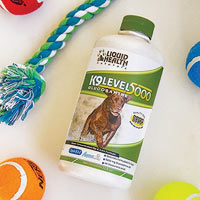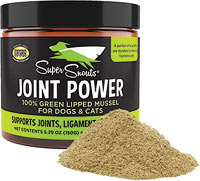Joint health is a critical component of your dog’s overall well-being. As dogs age, or in some cases even during their youth, they may experience joint issues such as osteoarthritis, hip dysplasia, or general stiffness. Glucosamine therapy has emerged as a popular and effective treatment option for managing these conditions. This article explores what glucosamine is, its benefits for dogs, how it works, and considerations for its use in therapy.
What Is Glucosamine?
Glucosamine is a naturally occurring compound found in cartilage, the tissue that cushions joints. It plays a vital role in maintaining joint health by supporting the production and repair of cartilage and synovial fluid, which lubricates the joints.
In dogs, glucosamine is often used as a dietary supplement to treat conditions affecting mobility and joint function. It can be administered as a standalone treatment or combined with other supplements like chondroitin sulfate and omega-3 fatty acids for enhanced benefits.

The Benefits of Glucosamine Therapy
Glucosamine offers several benefits for dogs, particularly those suffering from joint-related issues. These include:
1. Cartilage Repair and Maintenance: Glucosamine helps repair damaged cartilage and slow the degradation process, which is critical for dogs with arthritis or degenerative joint conditions.
2. Pain Relief: By improving joint function and reducing inflammation, glucosamine can alleviate pain and discomfort, allowing dogs to move more freely.
3. Improved Mobility: Regular glucosamine supplementation can enhance a dog’s mobility by restoring flexibility and cushioning in their joints.
4. Prevention of Joint Issues: In younger or active dogs, glucosamine may help prevent joint issues by maintaining healthy cartilage and joint fluid.
5. Reduced Dependence on NSAIDs: Nonsteroidal anti-inflammatory drugs (NSAIDs) are often prescribed for joint pain, but long-term use can have side effects. Glucosamine offers a natural alternative that reduces the need for NSAIDs.
Conditions Treated with Glucosamine
Glucosamine therapy is most commonly used to treat the following conditions -
1. Osteoarthritis: A degenerative joint disease that affects a significant number of older dogs, causing pain, stiffness, and reduced mobility.
2. Hip Dysplasia: A genetic condition where the hip joint doesn’t fit properly into the socket, leading to discomfort and joint damage over time.
3. Elbow Dysplasia: Similar to hip dysplasia but affecting the elbow joint.
4. Joint Injuries: Glucosamine can aid in recovery from joint injuries by supporting cartilage repair.
5. Preventative Care: Active or large-breed dogs prone to joint issues may benefit from glucosamine as a preventative measure.
How Does Glucosamine Work?
Glucosamine supplements are typically derived from shellfish or synthetically produced. When ingested, glucosamine is absorbed into the bloodstream and delivered to the joints, where it helps stimulate the production of glycosaminoglycans. These molecules are essential for maintaining healthy cartilage and synovial fluid.
In cases of joint damage, glucosamine helps to rebuild cartilage and reduce inflammation, improving joint function and relieving pain. While it’s not a quick fix—results often take weeks to months—it’s a long-term solution for managing joint health.
Types of Glucosamine for Dogs
Glucosamine supplements come in various forms, each with its advantages:
1. Glucosamine Hydrochloride (HCl): This is the purest form of glucosamine and is often used in veterinary supplements due to its high potency.
2. Glucosamine Sulfate: Often paired with sulfur to aid in cartilage repair, this form is commonly used in human supplements but is effective for dogs as well.
3. N-Acetyl-Glucosamine (NAG): A derivative of glucosamine, NAG is often used to support gastrointestinal health but can also benefit joint cartilage.
4. Combination Supplements: Many glucosamine products are combined with other ingredients like chondroitin sulfate, MSM (methylsulfonylmethane), or omega-3 fatty acids for added joint support.
Dosage and Administration
The appropriate glucosamine dosage depends on your dog’s size, age, and the severity of their condition. Here’s a general guideline:
• Small dogs (<25 lbs): 250-500 mg per day
• Medium dogs (25-50 lbs): 500-1000 mg per day
• Large dogs (50-100 lbs): 1000-1500 mg per day
• Giant dogs (>100 lbs): 1500-2000 mg per day
Glucosamine is available in various forms, including tablets, chewables, powders, and liquid supplements, making it easy to find an option your dog will accept. It can be administered with food to improve palatability and absorption.
When to Start Glucosamine Therapy
While glucosamine is often associated with older dogs, it can be beneficial for dogs of all ages. Consider starting glucosamine therapy if:
1. Your dog shows signs of joint pain, such as limping, stiffness, or reluctance to jump or climb stairs.
2. Your veterinarian diagnoses a joint condition like arthritis or hip dysplasia.
3. You own a breed prone to joint issues, such as Labrador Retrievers, German Shepherds, or Golden Retrievers.
4. Your dog is highly active or participates in sports, which can strain their joints.
Potential Side Effects and Risks
Glucosamine is generally considered safe for dogs when used as directed. However, some dogs may experience mild side effects, such as:
• Upset stomach
• Diarrhea
• Allergic reactions (rare, usually related to shellfish-derived glucosamine)
How Long Does It Take to See Results?
Glucosamine is not an immediate solution. Most dogs require 4-6 weeks of consistent supplementation before noticeable improvements in mobility and pain relief occur. However, the long-term benefits are well worth the wait, as glucosamine helps to rebuild and maintain healthy joints over time.
Choosing the Right Product
With countless glucosamine supplements on the market, choosing the right one can be overwhelming. Here are some tips:
• Look for products specifically formulated for dogs.
• Choose supplements that include complementary ingredients like chondroitin and MSM for added joint support.
• Opt for trusted brands with positive reviews and veterinary endorsements.
• Ensure the product has clear dosage instructions based on your dog’s weight.
Glucosamine therapy is a safe, effective, and natural way to support your dog’s joint health. Whether your dog is dealing with arthritis, recovering from an injury, or simply aging gracefully, glucosamine can help improve their quality of life.
As with any supplement, it’s essential to consult your veterinarian to ensure glucosamine is the right choice for your dog. With proper care and the right treatment, your furry friend can enjoy a life full of mobility, comfort, and joy.
|